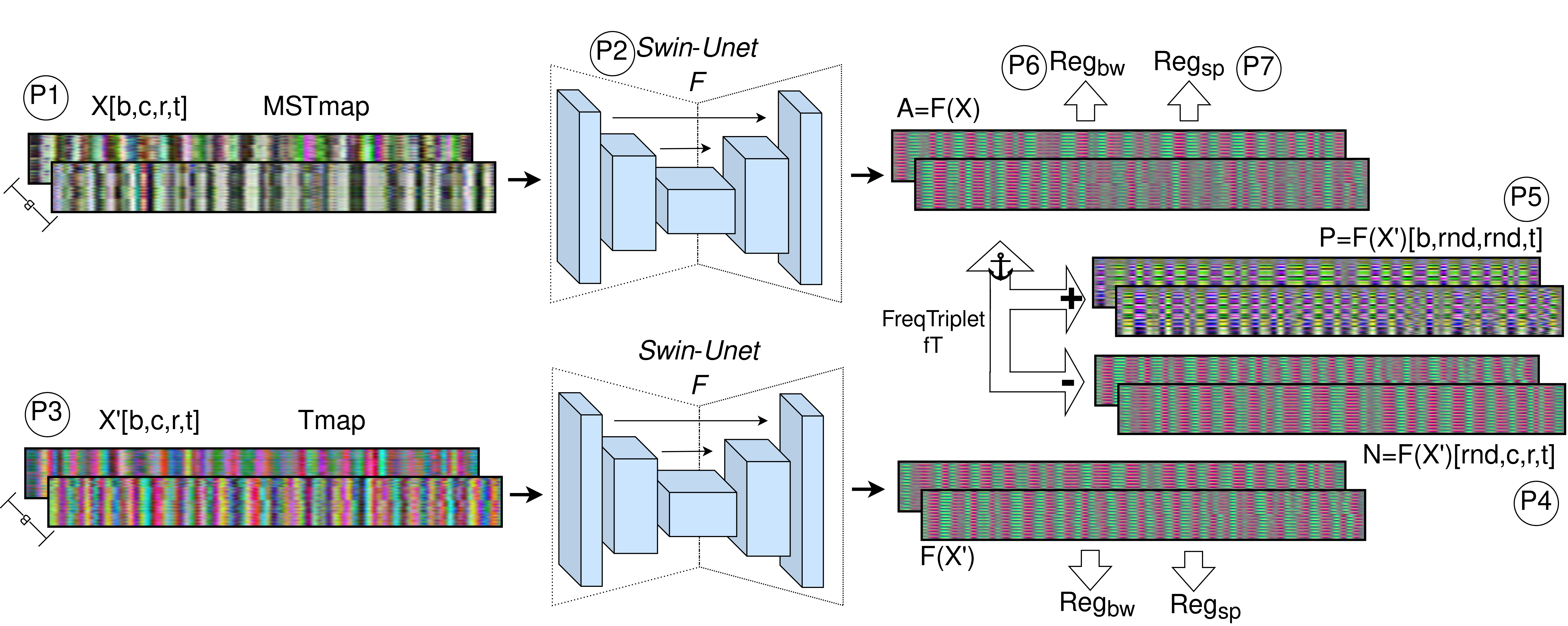This is the official code repository of our IEEE FG 2024 paper "RS-rPPG: Robust Self-Supervised Learning for rPPG". RS-rPPG is a novel contrastive framework that leverages a large set of priors, that enable learning robust and transferable features even from challenging datasets. Ours is the first method to focus on self-supervised learning on challenging data and the first method to use such a large set of priors. The priors include a novel traditional augmentation method, leveraging spatial-temporal maps and self-attention based transformer for SSL.
You can find the paper at Here
 A) rPPG: Cardiac activity causes periodical variations in the reflected light inten-
sity, noise is also captured (from e.g., lighting, motion and sensor). B) PPG: Uses simple
optical sensor to capture strong signal, due to short distance and lesser noise. C) rPPG ex-
traction: a coarse rPPG signal is obtained by selecting an ROI (e.g., cheeks or forehead) and
averaging the pixels from each frame to extract a temporal signal
A) rPPG: Cardiac activity causes periodical variations in the reflected light inten-
sity, noise is also captured (from e.g., lighting, motion and sensor). B) PPG: Uses simple
optical sensor to capture strong signal, due to short distance and lesser noise. C) rPPG ex-
traction: a coarse rPPG signal is obtained by selecting an ROI (e.g., cheeks or forehead) and
averaging the pixels from each frame to extract a temporal signal
 Our method relies on the following priors motivated by observations about rPPG:
Our method relies on the following priors motivated by observations about rPPG:
P1) Spatial-temporal maps are less subject to noise. -> STmap input
P2) Self-attention based transformers can lead to better temporal modelling -> SwinU-Net model
P3) Signals extracted using traditional methods contain more physiological information than raw averaged signals. -> Tmap positive sampling
P4) Different facial videos most likely contain different rPPG signals -> Instance wise sampling for negative sampling
P5) STmap signals are spatially and channel redundant -> Spatial and channel consistency in positive sampling
P6) The rPPG signal is band limited [0.5, 3]Hz -> Regbw
P7) The spectrum of rPPG signals is sparse -> Regsp
The original videos are firstly preprocessed by extracting the MSTmaps following https://github.com/nxsEdson/CVD-Physiological-Measurement. Both the MSTmaps and groundtruth bvp are resampled to 30 fps. To get the TMap positive augmentation maps use create_tmaps_VIPL.sh on your dataset. In the example code we assume the data used in pre-processed from PURE, OBF, MMSE or VIPL-HR datasets, but can't provide the actual data or preprocessed files. The structure of the data that can be used with our dataloader is:
Dataset1:
├── Sample1
├──├── mstmap.npy (containts [63,T,3] multi-scale spatial-temporal maps calculated from videos)
├──├── tmap.npy (containts [63,T,3] traditional augmenation calculated from the mstmaps by using create_tmaps_VIPL.sh)
├──├── bvp.npy ( array with grountruth bvp signal [T])
If your dataset is processed in this way, with some minimal code changes you can use our dataloader as described by the following steps.
Please make sure your dataset is processed as described above. Firstly you need to pre-train the SwinU-Net network to predict tmaps from mstmaps, this can be done with the pretrain_mstmap2tmap.py script. Put the pretrained models into a folder named "./Trained/" and then you can finally train using the rsrppg method by using train_rsrppg.py.
@inproceedings{savic2024rs, title={RS-rPPG: Robust Self-Supervised Learning for rPPG}, author={Savic, Marko and Zhao, Guoying}, booktitle={2024 IEEE 18th International Conference on Automatic Face and Gesture Recognition (FG)}, pages={1--10}, year={2024}, organization={IEEE} }